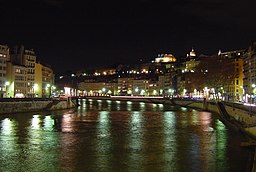Saône (river)
| Saône (La Saône) | |
| Sona | |
| River | |
|
The Saône in Lyon by night.
|
|
| Country | France |
|---|---|
| Tributaries | |
| - left | Doubs, Lanterne |
| - right | Azergues, Morgon |
| Source | Vioménil |
| - location | Vosges |
| - elevation | 392 m (1,286 ft) |
| - coordinates | 48°05′40″N 6°10′55″E / 48.094444°N 6.181944°E |
| Mouth | Rhône |
| - location | Lyon, France |
| - elevation | 158 m (518 ft) |
| - coordinates | 45°43′39″N 4°49′4″E / 45.72750°N 4.81778°ECoordinates: 45°43′39″N 4°49′4″E / 45.72750°N 4.81778°E |
| Length | 473 km (294 mi) |
| Area | 29,950 km2 (11,564 sq mi) |
| Discharge | |
| - average | 410 m3/s (14,479 cu ft/s) |
The Saône (French: La Saône French pronunciation: [soːn];Arpitan Sona, Latin: Arar) is a river of eastern France. It is a right tributary of the Rhône, rising at Vioménil in the Vosges department and joining the Rhône in Lyon, just south of the Presqu'île.
The name "Saône" derives from that of the Gallic river goddess Souconna, which has also been connected with a local Celtic tribe, the Sequanes. Monastic copyists progressively transformed "Souconna" to "Saoconna", which ultimately gave rise to "Saône". The other recorded ancient names for the river were Brigoulus and Arar.
The Saône rises at Vioménil at the foot of the cliff of the Faucilles in the Vosges at an elevation of 392 metres (1,286 ft), and flows into the Rhône at Lyon at an elevation of 158 metres (518 ft). Its length is 480 kilometres (300 mi). Its largest tributary is the Doubs; upstream of receiving the Doubs at Verdun-sur-le-Doubs in Saône-et-Loire, the Saône is called the "Petite Saône" (lesser Saône), which reflects the large contribution of the Doubs to the Saône. In fact the Doubs' mean annual flow rate is slightly stronger than that of the Petite Saône, 175 cubic metres per second (6,200 cu ft/s) compared to 160 cubic metres per second (5,700 cu ft/s); some thus assert that it is in fact the Saône that flows into the Doubs. Nonetheless the Saône has a substantially larger watershed than the Doubs, at 11,500 square kilometres (4,400 sq mi) vs. 7,500 square kilometres (2,900 sq mi).
...
Wikipedia

